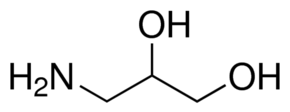Best Place for Pharmaceuticals & Chemicals




Phone Number
+91 84518 40941




+91 84518 40941
3-Amino-1,2-propanediol (CAS No. 616-30-8) is primarily used in the production of iohexol, a non-ionic contrast medium for X-ray computed tomography (X-CT). It serves as a key starting material in the synthesis of this contrast agent. Additionally, it is used in the production of various specialty materials for industrial and pharmaceutical applications. Seema Finechem Industry LLP provides high-quality 3-Amino-1,2-propanediol, meeting international standards for both research and commercial needs.


Amino alcohols possess both the physical and chemical characteristics of alcohols and amines within a single molecule. These versatile compounds are highly valuable and find applications across a wide range of industries.
Amino alcohols are versatile intermediates widely used in various synthetic processes. They undergo several common chemical reactions that lead to the formation of different compounds, including:
These reactions demonstrate the broad applicability of amino alcohols in the synthesis of diverse chemical compounds.
Amino alcohols are widely used in the production of efficient anionic emulsifiers and nonionic polyethylene emulsions. These emulsifiers are commonly found in personal care product formulations, offering advantages such as better base strength, lower neutral equivalent, and reduced volatility compared to traditional amine emulsifiers. In personal care products, amino alcohols function to neutralize acidic raw materials and enhance the water solubility of resinous materials. They provide excellent base strength, low odor levels, good solubility in both water and alcohol, and color stability, making them ideal for use in cosmetics.
The difunctionality of amino alcohols makes them valuable raw materials in polymer applications, both water- and solvent-based. They help increase the solubility of other components and improve solution stability. Amino alcohols also act as dispersants in pigment dispersion, enhancing wetting properties and viscosity stability. Additionally, the salts of amino alcohols are used in coatings to improve package stability, further enhancing the performance of the final product.
Amino alcohols help maintain a consistent alkalinity in boiling water flows and condensates, preventing the formation of solid products that could obstruct flow. This property makes them effective corrosion inhibitors. They are widely used in the production of water-soluble cationic flocculants and ion exchange resins, which adsorb solid and colloidal particles through electrostatic attraction. Amino alcohols are also employed in various applications, including water treatment, metal treatment, and the absorption of CO2 gas.
The salts of amino alcohols, including hydrochloride, nitrate, sulfate, phosphate, and sulfonate salts, can be used either alone or in combination with other catalysts to provide balanced curing action with selected textile resins. These salts enhance the curing process, ensuring optimal performance and effectiveness in textile applications.
In the biological field, the amino alcohol structure is commonly found in many drugs, particularly antihistamines. Sphingosine, an amino alcohol, serves as the major base for sphingolipids in mammals, playing a crucial role in signal transmission and cell recognition. Amino alcohol compounds are also key starting materials in the synthesis of beta-lactam antibiotics, humectants for food and cosmetics, flavoring agents, and various pharmaceuticals, including oral, injectable, and topical forms. Additionally, amino alcohols function as amine buffers in a wide range of medications.